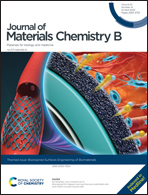Engineering surface patterns on nanoparticles: new insights into nano-bio interactions
Abstract
The surface properties of nanoparticles affect their fate in biological systems. Based on nanotechnology and its methodology, pioneering studies have explored the effects of chemical surface patterns on the behavior of nanoparticles and provided many new insights into nano-bio interfaces. In this review, we would like to provide a summary of how the nanoparticle surface pattern modulates its biological effects. The relationship between the surface pattern of nanoparticles and the generated interaction with cell membranes, recognition of viruses and adsorption of proteins was discussed. On this basis, we believe that a reasonable design of the surface microstructure will promote the application of artificial nanoparticles in biomedicine and provide a new strategy for improving the design of nano-drug carriers.

- This article is part of the themed collection: Bioinspired Surfaces Engineering for Biomaterials


 Please wait while we load your content...
Please wait while we load your content...